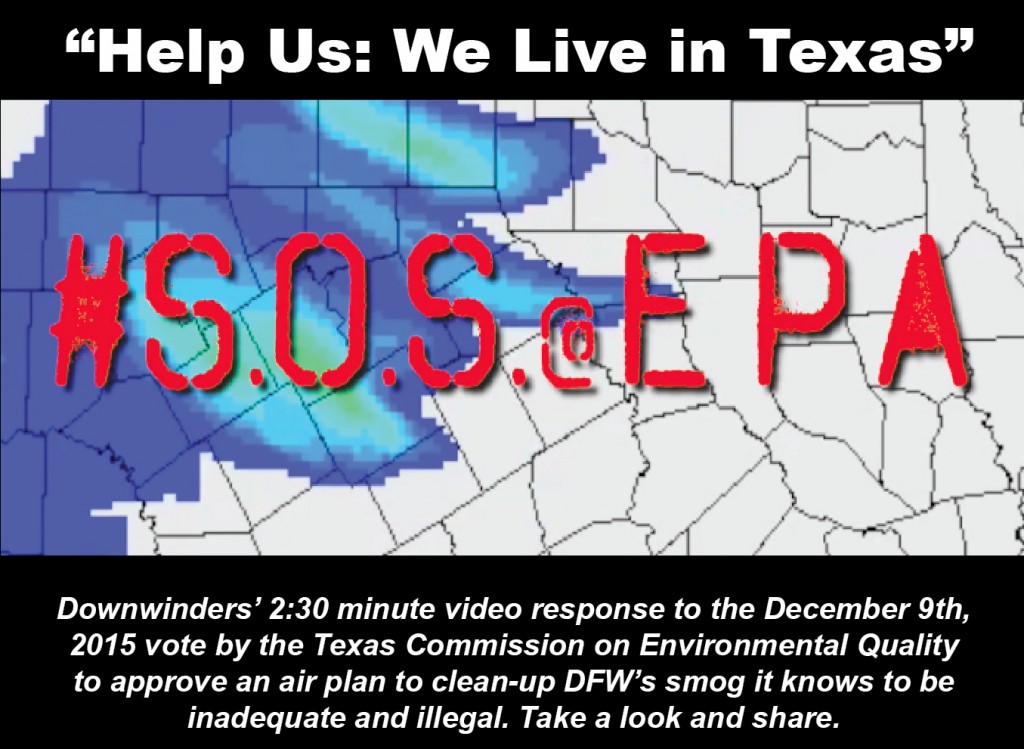Air Quality
The Fastest Way to Get Big Cuts in Climate Change Pollution? A Good DFW Anti-Smog Plan.
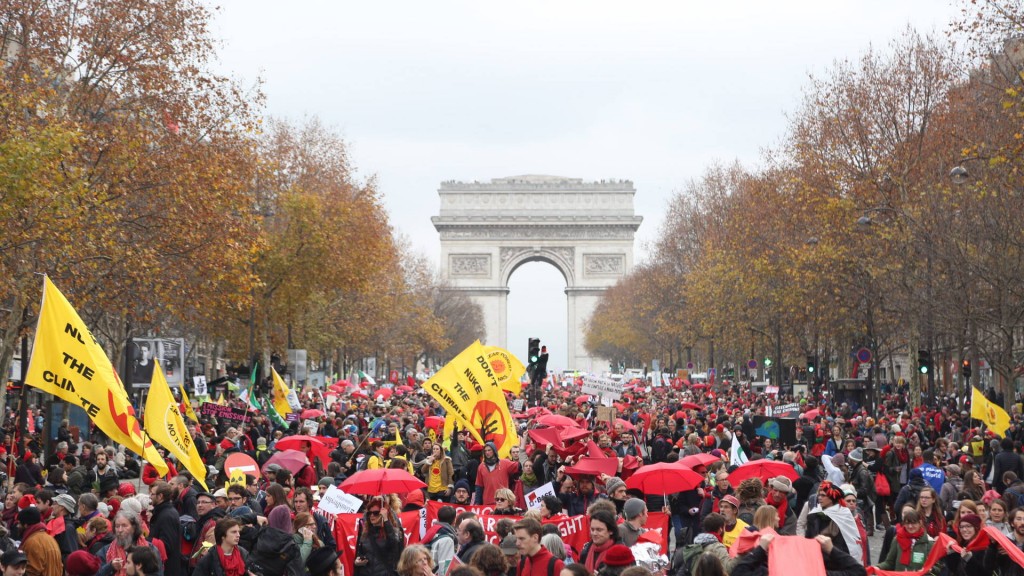
Public Hearing
6:30 pm Thursday
January 21st
616 Six Flags Drive Arlington
When polluters cut smog pollution, they cut a lot of other kinds of pollution as well, including climate-damaging gases like CO2 and methane.
Hundreds of thousands of tons of this kind of pollution could be eliminated in the next air plan for Dallas-Ft. Worth as a result of requiring modern controls on coal plants, cement kilns, and oil and gas sources.
Luminant's Martin Lake coal plant in East Texas is the largest global warming polluter in the country. It released 16.3 million metric tons of carbon dioxide in 2012, the equivalent of 3.5 million cars.
Recent studies show facilities in the Barnett Shale Gas Play are leaking 50% to 90% more methane than the government estimates.
We need to cut pollution here, now.
That's why if you care about climate change, you'll want to show-up next Thursday night and speak in favor of the EPA rejecting a State of Texas plan that doesn't require any new cuts in pollution from any source.
Join your earth-hugging peers in calling for a new air plan written by EPA that includes cuts in local smog pollution that can also benefit the entire planet. In as little as two years, you could make a big difference to a big problem.
Think Globally. Act Locally.
Not just a bumper sticker.
Additional Talking Points here if you need them.
SPECIFICS?
When the Ash Grove cement plant in Midlothian modernized its operations to conform with new anti-smog rules and other regulations, it cut approximately 300,000 tons of CO2 pollution – a year. That's just one cement plant.
Methane is the main ingredient in natural gas, and a highly potent greenhouse gas, with over 80 times the 20-year warming power of carbon dioxide.
EPA estimates 750,000 to one million tons of methane is released by equipment leaks every year from facilities in the Barnett Shale, but a recent peer-reviewed study estimated methane emissions in the Barnett Shale may be twice as high as EPA thinks.
There are pending EPA rules to limit methane pollution at natural gas sites that could be rolled into this DFW air plan. Even a 50% cut in leaks in North Texas would mean an annual drop of 400-500,000 tons of climate changing pollution.
A good anti-smog plan from EPA will also put more pressure on the obsolete East Texas coal plants to close.These coal plants are the biggest reasons Texas status is the #1 Greenhouse Gas polluter in the U.S.
The fastest way to cut lots of greenhouse gases in the Belly of the Beast is with a good EPA anti-smog plan for DFW.
Come speak in support of an air plan for our region that would help reduce asthma attacks here, and the melting of glaciers in Greenland.
Thursday, January 21st
6:30 pm
616 Six Flags Road in Arlington
First Floor Meeting Room
– Send EPA Administrators an email asking them to reject the State's do nothing DFW air plan and instead wrie one of their own.
– Sign the CHANGE.ORG Petition urging EPA to reject the State's air plan for DFW
It’s a Texas vs EPA Cage Match. Winner Takes All …The Air You Breathe
 JOIN OUR TAG TEAM EFFORT TO TAKE DOWN THE STATE OF TEXAS
JOIN OUR TAG TEAM EFFORT TO TAKE DOWN THE STATE OF TEXAS
BUT WATCH OUT – THEY PLAY DIRTY
NEXT THURSDAY EVENING
JANUARY 21st
6:30 PM
616 Six Flags Road
First Floor HQ of the
North Central Texas Council of Governments
There's an important bureaucratic cage match between EPA and the State over how clean your air should be.
The state says just by hitching a ride on already-in-progress federal gasoline mix for cars and trucks, DFW ozone, or smog, will drop to levels "close enough" to the current federal smog standard of 75 parts per billion (approximately 78 ppb) . No new cuts in pollution required.
The EPA says not so fast – "close enough" may not be good enough this time around and you're not following the Clean Air Act in laying back and requiring no new cuts in pollution.
EPA has told Austin a failure to follow Clean Air Act rules will force it to take responsibility for the plan away from the State.
Is this something you want? If so, you should show up and next Thursday evening to give the EPA the political support it needs to pull the rug out from under the State.
WHAT HAS THE EPA ALREADY SAID ABOUT THE STATE'S PLAN?
Along with comments from DFW residents, environmental groups, doctors, industry and elected officials, EPA itself will weigh-in with written comments on the TCEQ plan by the deadline of January 29th.
But we don't have to wait that long to find out what EPA really thinks about what the State is proposing. Last year, EPA provided 11 pages of comments on exactly the same plan.
1) This plan won't work without more cuts in pollution
What EPA Said:
"Based on the monitoring data and lack of additional large reductions in NOx within areas of Texas that impact DFW, it is difficult to see how the area would reach attainment in 2018 based solely on federal measures reductions from mobile and non-road….The recent court decision that indicates the attainment year will likely be 2017 for moderate classification areas such as DFW, makes it less clear that the area will attain the standard by 2017 without additional reductions."
What EPA Meant:
It wasn't looking good when the deadline for reaching the 75 ppb standard was 2018 and the State didn't require any new cuts in air pollution, but now that the deadline is 2017, your do-nothing "close enough" plan is even less likely to work.
2) Your case for doing nothing isn't very good
What EPA Said:
"While the State has provided a large chapter on Weight of Evidence, the principal evidence is the recent monitor data. The monitor data does not show the large drops in local ozone levels and therefore raises a fundamental question whether the photochemical modeling is working as an accurate tool for assessing attainment in 2018 for DFW."
What EPA Meant:
Actual measurements of smog in DFW seem to undercut your claim that the air is getting cleaner faster. Maybe your computer model that's driving the entire plan isn't all that great. (And this was before smog levels went UP after the summer of 2015 – something not predicted by the State's model….)
3) Review pollution limits for the Midlothian cement kilns, or we'll reject your plan
What EPA Said:
"Because of significant changes in the type and number of cement kilns in Ellis County,…TCEQ's rules need to be reevaluated to insure these reductions are maintained, and the emission limits reflect a Reasonably Available Control Technology (RACT) level of control as required by the Clean Air Act…Failure to conduct a thorough RACT analysis for cement kilns which would include appropriate emission limits would prevent us from approving the RACT portion of the attainment plan submittal."
What EPA Meant:
Update your kiln pollution limits, or this part of the plan is toast. (Texas chose not to perform this update, in essence, giving EPA the bureaucratic finger.)
4) Oil and Gas pollution seems to be keeping the region's smog levels higher than they should be
What EPA Said:
"Recent NOx trends (Figure 5-10 in TCEQ's Proposal) indicate a fairly flat NOx trend for several NO monitors in the western area of the DFW area (Eagle Mtn. Lake, Denton, and Parker County monitors). These monitors are in areas more impacted by the growth in NOx sources for Oil and Gas Development that seem to be countering the normal reduction in NOx levels seen at other monitors due to fleet turnover reductions (on-road and Nonroad). These higher NOx levels in the modeling domain that seem to be fairly flat with no change since 2009
raise concern that the area is not seeing the NOx reductions needed to bring the ozone levels down at these monitors."
What EPA Meant:
Since the historically worst-performing air pollution monitors in DFW are located in exactly the same area as a lot of gas and oil activity, and these monitors haven't been seeing the expected decrease in smog you predict, maybe you ought to think about cutting pollution from those oil and gas sources. Like we said, this plan needs more cuts in pollution.
5) Your own evidence supports cuts in pollution from the East Texas Coal Plants
What EPA Said:
"The TCEQ provided an evaluation of emissions from all of the utility electric generators in east and central Texas. However, the discussion in Appendix D on the formation, background levels, and transport of ozone strongly supports the implementation of controls on NOx sources located to the east and southeast of the DFW nonattainment area. How would a reduction in NOx emissions from utility electric generators in just the counties closest to the eastern and southern boundaries of the DFW area impact the DFW area?"
What EPA Meant:
Despite your protests, the State's own analysis shows cuts in pollution from the East Texas Coal Plants have a big impact on DFW smog levels and supports the argument for putting new controls on them. Did you actually run your fancy-dancy computer model to see what would happen if you did that? (No, the State did not. But UNT and Downwinders did.)
WHY WOULD AN EPA PLAN FOR DFW AIR MAKE ANY DIFFERENCE?

If the EPA rejects the State's plan, the clock begins ticking: the State is warned it has to write a new plan and, meanwhile, EPA begins to write its own. If the State doesn't turn in a plan the EPA finds acceptable in 24 months, the EPA plan is implemented instead.
The State has no interest in any new cuts of pollution from any sources. It thinks it's plan is already "close enough."
If the EPA is writing the plan, citizens can use the new UNT study to show the Agency which cuts get the largest drops in smog – using the State's own air model.
We can use Dr.Haley's study to show the approximate economic and public health benefits of those cuts.
More change happens if EPA is writing the plan.Enough to finally get DFW safe and legal air? We don't know until we try. The alternative is doing nothing.
EPA Rejects Texas’ BS and Submits Its Own Air Plan for Parks. Will It Do the Same For People?
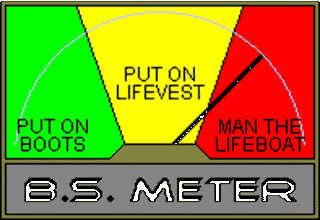 As you might have already heard, last week the EPA announced it was rejecting Texas' proposed rapid-response,140-year plan for restoring air quality and visibility in National Parks affected by pollution from the state's largest industrial facilities, primarily coal-fired power plants, aka, "the haze rule."
As you might have already heard, last week the EPA announced it was rejecting Texas' proposed rapid-response,140-year plan for restoring air quality and visibility in National Parks affected by pollution from the state's largest industrial facilities, primarily coal-fired power plants, aka, "the haze rule."
Instead, the EPA decided to implement its own, slightly more decisive plan for action. Whereas the state concluded it needed no new controls on any coal plants, the EPA is requiring modern Sulfur Dioxide (SOx) scrubbers on 14 different boilers at nine power plant sites across the state it estimates will remove 230,000 tons of the pollutant annually. That's 60% of the state's total SOX pollution, and 7% of the nation's.
These scrubbers not only capture SOx on behalf of more beautiful vistas in Big Bend, they also do a good job of preventing lots of Particulate Matter pollution from reaching the lungs of people that live in between the coal plants and parks. Although computer modeling was used by EPA to determine the effectiveness of the scrubbers it's requiring, it focused on results inside the parks. Getting results for metro areas like DFW involves a lot of data mining nobody has done, but there's no question that if reductions in air pollution are helping Oklahoma and West Texas parks, they're also helping out the air in North Texas. Just one look at the modeling maps produced by our recent UNT study of DFW ozone shows the immense impacts of these plants on DFW air quality.
For residents of DFW, the reductions in pollution are overdue and welcome news (the process leading up to this rule can be traced all the way back to 1977), and it certainly makes it even less likely that the big bad old TXU plants (Big Brown, Monticello and Martin Lake) can escape their obsolescence after bankruptcy proceedings.
But the way the EPA determined to go it alone in this case may be much more important to DFW's own air quality in the long run as the actual reductions it implements.
Not to put too fine a point on it, but EPA called BS on the way Texas was obscuring the data needed to write a good haze rule plan. This M.O. sounds awfully familiar to citizens watching the way the State has drafted its anti-smog plan for DFW, now officially approved by the TCEQ Commissioners and on its way to a public hearing in Arlington on Thursday, January 21st (6 pm, HQ of North Central Texas Council of Governments, 616 Six Flags Road).
And if EPA is willing to stand-up to Texas over air quality in parks, shouldn't it take at least as strong a stand on behalf of seven million souls in DFW?
About the same time EPA was announcing a federal takeover of the haze rule plan, Downwinders released its new video appealing for help from the EPA to reject the State's do-nothing smog plan for DFW. A big part of our case is its reliance on faulty analysis and downplaying or obscuring evidence that contradicts the state's ideological position that no new pollution controls for smog are needed in a region in its third decade of continual violation of the Clean Air Act and after a summer where smog averages increased…twice.
Which makes the language EPA uses to justify this takeover of the haze rule plan all the more relevant, and gives residents some hope should the Agency apply the same logic to the State's pathetic response to DFW's chronic smog problem.
EPA accuses Texas of hiding the most effective control strategies from EPA and Oklahoma (where the Wichita Mountains Wildlife Refuge is affected by Texas-based pollution seven times as much as Oklahoma-based SOx) by flooding its emissions inventory data with both large and small sources of SOx from across the state, washing out the impact of the larger coal plants.
"During the interstate consultation required by the Regional Haze Rule, Oklahoma and Texas discussed the significant contribution of sources in Texas to visibility impairment at the Wichita Mountains, but Texas concluded that no additional controls were warranted for its sources during the first planning period to ensure reasonable progress at the Wichita Mountains, or at its own Class I areas, the Big Bend and the Guadalupe Mountains National Parks.
In reaching this conclusion, Texas relied on an analysis that obscured the benefits of potentially cost-effective controls on those sources or groups of sources with the largest visibility impacts in these Class I areas by inclusion of those controls with little visibility benefit, but which served to increase the total cost figures.
This flawed analysis deprived Oklahoma of the information it needed to properly assess the reasonableness of controls on Texas sources during the consultation process and prevented Texas from properly assessing the reasonableness of controls to remedy visibility at Big Bend and the Guadalupe Mountains.
A few pages later EPA reiterates the charge,
Texas’ analysis was deficient and not approvable because the large control set it selected was not appropriately refined, targeted, or focused on those sources having the most significant and potentially cost-effective visibility benefits. We conclude this control set included controls on sources that would increase total cost figures, but would achieve very little visibility benefit…because Texas only estimated the visibility benefit of all the controls together, it was not able to assess the potential benefit of controlling those sources with the greatest visibility impacts, and potentially cost-effective controls. Therefore, the effects of those controls with the greatest visibility benefits were obscured by the inclusion of those controls with little visibility benefit. This only served to increase the total cost figure, making Texas’ potential control set seem less attractive.
In analyzing whether additional controls should be required for some of its sources under the long-term strategy provisions of the Regional Haze Rule, Texas relied on the same flawed analysis discussed above that it relied on to evaluate additional controls under the reasonable progress provisions to address visibility impairment at Texas’ own Class I areas. Texas’ analytical approach obscured the contributions of individual sources that Texas’ own analysis indicated could be cost-effectively controlled.
This deprived Oklahoma of the information it needed to properly assess whether there were reasonable controls for Texas sources and to properly establish reasonable progress goals for the Wichita Mountains that included the resulting emission reductions.
That's just about as plain an outline of a state government conspiracy to avoid complying with the Clean Air Act as the EPA puts in print. And it sets the stage to examine the State's DFW air plan using the same fine-toothed comb for rooting-out analytical crap meant to obscure inconvenient facts on the ground.
For example, the State's conclusion that no new controls for smog are warranted is based on an analysis of what's "reasonably available" that's every bit as flawed as anything dreamed up by Austin for dodging its responsibilities to national parks. It ignores modern controls already operating on cement kilns, gas compressors, and coal plants – to the point of not even mentioning the permitting of these controls by the TCEQ itself.
Moreover, hard as it is to believe, the state's conclusion on smog controls is based on no modeling of the impact of those controls on air quality. That was left up to Downwinders and its UNT study, using the state's own computer modeling. What that effort provided was nothing less than a road map for how to get the most cost-effective cuts in smog by reducing pollution from those kilns, coal plants, and compressors. This is information the state could have gotten if it wanted it, but it didn't want it because it disputed the ideological position that no new pollution controls for industry are justified. It knew if it looked, it would have to release the results. So it just didn't look.
Finally, the state is still claiming that its plan will get DFW "close enough," to the 75 ppb standard, clocking-in at 77.8 ppb. So the plan doesn't even accomplish its goal. That makes it completely indistinguishable from the last five state air plans for DFW. What the State is counting on is EPA giving them credit for a wish list collection of unquantifiable stuff under the regulatory category of "Weight of Evidence." This is exactly the same strategy used in past plans. Ride new changes in federal law as far as you can and convince the EPA that "trends" are in your favor to make up any slack.
Only this time, "trends" may be working against the State. The summer of 2015 saw an increase in regional smog averages, indicating that perhaps its do-nothing approach isn't working. If you combine this information with the fact that smog levels also rose during the last do-noting plan from 2011, you have some "trends" crying out for an EPA takeover.
Since the TCEQ has approved its DFW air plan for submittal to EPA, we won't have to wait long to find out what the Agency's response will be. Public comments are due by January 29th. Let's hope EPA's review of an air plan for people's health in the nation's fourth largest metropolitan area is as rigorous as it was for the one looking out for visitors to the Wichita Mountains.
“Help Us. We Live in Texas.”
(Dallas)— “Help Us: We Live in Texas.”
That’s the plea of a video released today by a local clean air group claiming the state has so intentionally sabotaged Dallas-Fort Worth anti-smog efforts that residents now need EPA to take over the job.
“Texas is as likely to enforce the Clean Air Act in 2015 as Mississippi was to enforce the Voting Rights Act in 1965,” said Downwinders at Risk’s Director Jim Schermbeck, echoing a line in the video.
The group posted the 2:42 minute piece, titled “SOS @EPA” in response to this morning's vote by the Texas Commission on Environmental Quality (TCEQ) to move forward with a new anti-smog plan for DFW that the Commission has already been told by EPA falls short of legal and regulatory requirements.
In the video, footage from a Downwinders’ street action calling for help at EPA Regional Headquarters in downtown Dallas November 5th is spliced with facts about DFW’s 20 years and counting chronic smog problem. Central to the group’s charge is the state’s unwillingness to put new controls on major sources of industrial air pollution like the Midlothian cement kilns, East Texas coal plants, and gas facilities – despite the fact their own air modeling shows those controls could bring smog down enough to comply with the Clean Air Act.
Today’s vote by the TCEQ is the second in 12 months concerning the same DFW air plan. Its goal is to get from an average of 83 parts per billion (ppb) of smog in 2015 down to the current federal standard of 75 ppb by 2017.
However, the state only estimates a best-case result of almost 78 ppb. Despite that shortfall, there are no new pollution controls required of any major sources. Over the last 20 years, the state has written five anti-smog plans for DFW. None has accomplished its goal on deadline, and regional smog levels actually rose this year.
Besides once again failing to hit is mark overall, the EPA has already told the State its formal assessment of modern pollution controls for those major sources needed revisiting to be legal. TCEQ refused to comply with EPA and today’s plan contains exactly the same assessment as the one EPA has already said isn’t sufficient, making that part of the plan instantly illegal. Although EPA gives state governments authorization to write smog plans for their own metropolitan areas, it still has final approval based on criteria listed in the Clean Air Act.
One of the points made in the group’s video is that studies by local hospitals have shown DFW childhood asthma rates to be as much as four times the state average and over twice the national average, making the need for cleaner air imperative.
“The health of seven million Dallas-Fort Worth residents is being held hostage by a state government hostile to the goal of clean air. Only federal intervention can save us,” said Schermbeck.
The video can be found at Downwinders at Risk’s website (downwindersatrisk.org), it’s Facebook page, twitter account (@cleaner air) and the group’s YouTube channel (Downwinders’ TV).
__________________________________
SEND EPA ADMINISTRATORS A MESSAGE TO REJECT THE STATE'S PLAN AND WRITE ONE OF ITS OWN:
https://www.downwindersatrisk.org/featured-citizen-action/
AND
SIGN THE CHANGE.ORG PETITION:
https://www.change.org/p/ron-curry-and-gina-mccarthy-environmental-protection-agency-reject-texas-smog-plan-for-dallas-ft-worth
________________________________________
LIKE THIS VIDEO? LIKE OUR WORK? THINK IT'S IMPORTANT?
THEN PLEASE MAKE A TAX-DEDUCTABLE CONTRIBUTION TO DOWNWINDERS BEFORE DECEMBER 31st.
DONATE HERE.
________________________________________
WHY?
It might be hard to believe, but despite being the nation’s fourth largest metropolitan area, AND being in constant violation of the Clean Air Act for smog since 1991, AND having higher annual smog numbers than Houston, AND being singled out by EPA as one of only a handful of areas expecting to STILL be in violation of the Clean Air Act in 2025, there’s still only one professional staff person devoted to cleaning up DFW air: the staff person you pay for when you contribute to Downwinders at Risk.
Besides community organizing on the ground, Downwinders also had to go out and build a new committee of local officials concerned about dirty air after the traditional regional air quality planning process broke down. That committee produced a first-ever study showing how new pollution controls on the kilns, coal plants, and compressors could bring smog levels down enough to comply with the Clean Air Act. Our study was used by the Dallas Commissioners Court to pass a resolution requesting new controls on the East Texas coal plants in October. Had it not been for our new committee, there would have been no local officials involved in the DFW air quality planning process at all, and noaccountability for a state government that isn’t interested in our lungs.
Want to get just basic information about DFW air pollution? There are no dedicated environmental beat reporters left in DFW. Downwinders fills this gap as well, providing the only source of reliable and timely information on DFW air quality issues.
Need technical or organizing training? We do that too. Many of you know we just sponsored our first conference – the four-day Root and Branch Revue, featuring a graduating class of 70 grassroots activists from our first “University of Change.”
When you give to Downwinders, you fund the last line of defense between your lungs and a state government that doesn’t believe smog is that bad for you.
And when you give to Downwinders, you know you’re giving to a group with a two decade proven track record of getting results.
That’s our pitch. We get your donation. You get our best effort at protecting your lungs.
On behalf of myself, and the Downwinders at Risk board, thank you for your consideration.

Jim Schermbeck
Director, Downwinders at Risk
Study: Combusted PM Pollution Up to Five Times as Lethal As Non-Combusted Kind. Burning is Bad.
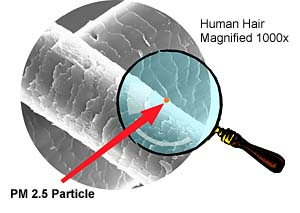 Long term exposure to small particulate pollution from combustion sources, specifically coal-fired power plants, is up to five time more likely to kill you through heart damage than other forms of natural or human-made "PM."
Long term exposure to small particulate pollution from combustion sources, specifically coal-fired power plants, is up to five time more likely to kill you through heart damage than other forms of natural or human-made "PM."
That's the conclusion of new comprehensive study comparing risks from breathing-in the tiniest specs of soot from combustion sources for over 450,000 Americans in 100 cities from 1984 to 2014. Published in the journal Environmental Health Perspectives this month to coincide with the Paris climate talks, the study has ten co-authors and promises to be a milestone in the long fight to reduce this form of pollution.
Combustion of any sort releases fine and ultra-fine particles of soot, or "Particulate Matter" in the often antiseptic regulatory-speak of environmental regulation. These specks differ from dust particles or fireplace soot in that they're much, much smaller and so can be inhaled deeper into the lungs, and then, even pass from the lungs into the blood steam to affect other organs and systems. It's their tiny size that makes PM pollution dangerous on its own. Over the last 30 years, scientists and public health officials have gone from being worried about PM 10 (10 microns or less), to PM 2.5 (2.5 microns or less – about 100th of the width of a human hair), to Ultra-fine Particles.
But soot from combustion also carries residues of whatever was being burned in the facility it came from, and this makes it doubly toxic. If you're burning coal, the soot might carry bits of Mercury, Arsenic, Cadmium and Lead, for example. The new study says that difference is what really drives up risk for people breathing-in coal plant PM.
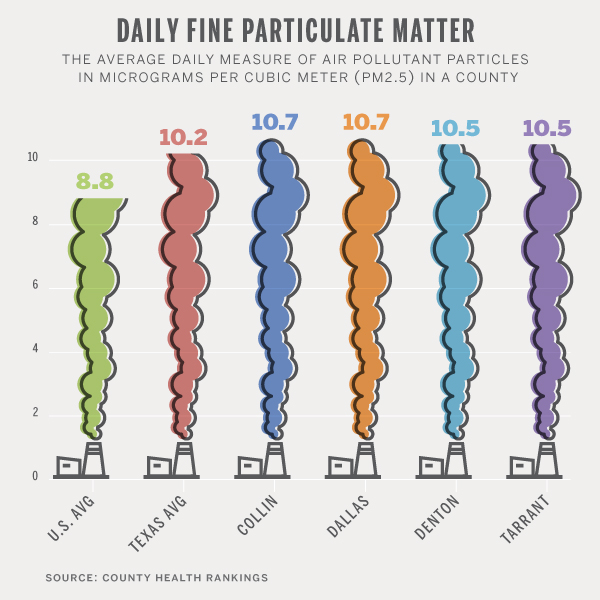
Locally, DFW is chock full of large industrial sources of combustible PM.
We're surrounded by five coal plants in an arc on its northeastern to southeastern side. That means we're downwind of their pollution, including their particulate matter pollution, most of the year. Their impact on local smog levels has recently been chronicled by Downwinders' study from UNT.
PM Pollution would follow approximately the same patterns although heavier particles fall closer to the source, while the really fine particles drift for hundreds or thousands of miles. Luminant’s 2013 Emissions Inventory submission reports 1400 tons of 2.5 particulate matter in a single year at its Big Brown plant. And that may be a severe underestimate. Big Brown’s two Units have exceeded the Texas SIP’s opacity limit of 30 percent on thousands of occasions over the past decade.
Luminant's Martin Creek plant released 2,018 pounds of mercury into the environment in 2013, according to the Toxic Release Inventory, and in fact Texas hosted the top three mercury polluters among all coal plants in the US that year.
Closer in, there's the three Midlothian cement plants with a total of four kilns now. Modernization and controls forced by 20 years of campaigning by Downwinders have brought the numbers down dramatically, but they're still huge facilities that deal in both a dusty raw material, and burning lots of coal and industrial wastes like tires and used oil, and even car parts, to turn that into a higher grade of raw material. When you burn exotic materials with coal, you turbocharge the toxicity of the PM pollution even more. In 2013, the last year the state has numbers posted online, the three cement plants released approximately 440 tons of 2.5 PM pollution.
But cement plants weren't included in the study and so the risk evaluations in it for DFW are underestimated.
Midlothian is also the home to the very large French-owned Amersteel (formally Chaparral Steel) secondary steel mill and steel mills were included as a source category in the study and were also associated with a higher mortality rate. Just about every 18-wheeler trailer you see on local highways loaded with crushed cars is headed to this facility – across the street from the TXI cement plant. Imagine the residues on the soot from melting down thousands of used cars into liquid metal. In 2013, the plant released 133 tons of PM 2.5.
But by far, the largest PM polluter in the DFW area, bar none is the Owens-Corning fibreglass plant in north Waxahahchie, along I-45. It released a whopping 300 tons of PM 2.5 pollution in 2013 alone. No other facility comes close – not the cement plants or the steel mill down 287. Not the GM plant in Arlington. It's not known how much of Owens-Corning PM is combusted however. It could be from the manufactiuring process.
Diesel engines in vehicles were also included, and the study found they has an association with higher mortality, but not nearly as significant as coal plants or steel mills. There's been a steady stream of studies tying highway pollution to respiratory and neurological illness among near-by populations, especially children. Most of the risk is assigned to PM pollution, and most of that is coming from diesels.
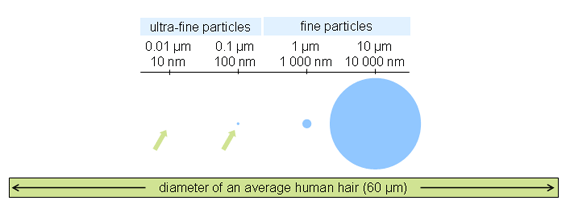
Just as important as the conclusion that coal-combusted particulate matter is significantly more dangerous than your average speck of dust is the study's indictment of current EPA risk assessments that operate on exactly the opposite assumption. The authors are critical that the Agency still weighs the risk of desert dust the same as combusted soot in computing long-term human health effects.
There are potentially enormous public heath and policy implications for North Texans in the study's conclusions.
First, the campaign to get the most modern anti-smog controls included in the latest DFW air plan has the side benefit of reducing PM pollution too. Selective Catalytic Reduction (SCR) on the cement kilns and coal plants decreases smog-forming pollution by up to 90%, and makes an effective additional PM catcher as well, increasing soot capture by 30-50%. The technology is particularly effective on the kind of PM that carries dangerous heavy metals like Mercury. Of course, retiring already-obsolete coal plants would eliminate the threat all together.
Likewise, electrification of compressors would not only lead to decreases in smog-forming emissions, but PM pollution from those sources as well.
Next, it means the already large public health costs of bad air in DFW just published by Dr. Robert Haley of UTSW in his own study are severely underestimated, since they were based on the EPA's own risk assessment software that doesn't weigh the harm of coal power plant PM differently from any other speck of PM 2.5. Adjust those numbers for the exposure to toxic soot and you could see a huge increase in lives lost, illness caused, and dollars spent.
Finally there are implications for almost very other source of combustion around – burning is bad. Where's there's a flame, a boiler, a furnace, a process that means burning something to get something in return, there's going to be PM pollution. What you burn is as important as how you burn it. Burn coal and get the residues of coal on the PM. Burn hazardous waste, and you get the residues from those wastes on the PM. Burn diesel fuel in your truck or car and get residues from that fuel mix packed away in your particulate matter.
As one of the major authors of the study said, if you want to do something about this kind of pollution – start with the most toxic forms of combusted PM. Those mostly come from large industrial sources – the coal plants, cement kilns, and compressors already in our sights because they're also smog polluters. We knew they were a problem. Now we know even more about why they're a bigger problem.
“Help: We Live in Texas.” Our Response to Today’s TCEQ Vote on the DFW Air Plan
(Dallas)— “Help Us: We Live in Texas.”
That’s the plea of a video released today by a local clean air group claiming the state has so intentionally sabotaged Dallas-Fort Worth anti-smog efforts that residents now need EPA to take over the job.
“Texas is as likely to enforce the Clean Air Act in 2015 as Mississippi was to enforce the Voting Rights Act in 1965,” said Downwinders at Risk’s Director Jim Schermbeck, echoing a line in the video.
The group posted the 2:42 minute piece, titled “SOS @EPA” in response to this morning's vote by the Texas Commission on Environmental Quality (TCEQ) to move forward with a new anti-smog plan for DFW that the Commission has already been told by EPA falls short of legal and regulatory requirements.
In the video, footage from a Downwinders’ street action calling for help at EPA Regional Headquarters in downtown Dallas November 5th is spliced with facts about DFW’s 20 years and counting chronic smog problem. Central to the group’s charge is the state’s unwillingness to put new controls on major sources of industrial air pollution like the Midlothian cement kilns, East Texas coal plants, and gas facilities – despite the fact their own air modeling shows those controls could bring smog down enough to comply with the Clean Air Act.
Today’s vote by the TCEQ is the second in 12 months concerning the same DFW air plan. Its goal is to get from an average of 83 parts per billion (ppb) of smog in 2015 down to the current federal standard of 75 ppb by 2017. However, the state only estimates a best-case result of almost 78 ppb. Despite that shortfall, there are no new pollution controls required of any major sources. Over the last 20 years, the state has written five anti-smog plans for DFW. None has accomplished its goal on deadline, and regional smog levels actually rose this year.
Besides once again failing to hit is mark overall, the EPA has already told the State its formal assessment of modern pollution controls for those major sources needed revisiting to be legal. TCEQ refused to comply with EPA and today’s plan contains exactly the same assessment as the one EPA has already said isn’t sufficient, making that part of the plan instantly illegal. Although EPA gives state governments authorization to write smog plans for their own metropolitan areas, it still has final approval based on criteria listed in the Clean Air Act.
One of the points made in the group’s video is that studies by local hospitals have shown DFW childhood asthma rates to be as much as four times the state average and over twice the national average, making the need for cleaner air imperative.
“The health of seven million Dallas-Fort Worth residents is being held hostage by a state government hostile to the goal of clean air. Only federal intervention can save us,” said Schermbeck.
The video can be found at Downwinders at Risk’s website (downwindersatrisk.org), it’s Facebook page, twitter account (@cleaner air) and the group’s YouTube channel (Downwinders’ TV).
__________________________________________________________________________________________
SEND EPA ADMINISTRATORS A MESSAGE TO REJECT THE STATE'S PLAN AND WRITE ONE OF ITS OWN:
https://www.downwindersatrisk.org/featured-citizen-action/
SIGN THE CHANGE.ORG PETITION:
____________________________________________________________________________________
LIKE THIS VIDEO? LIKE OUR WORK? THINK IT'S IMPORTANT?
THEN PLEASE MAKE A TAX-DEDUCTABLE CONTRIBUTION TO DOWNWINDERS BEFORE DECEMBER 31st.
________________________________________________________________________________________
WHY?
It might be hard to believe, but despite being the nation’s fourth largest metropolitan area, and being in constant violation of the Clean Air Act for smog since 1991, and having higher annual smog numbers than Houston, and being singled out by EPA as one of only a handful of areas expecting to STILL be in violation of the Clean Air Act in 2025, there’s still only one professional staff person devoted to cleaning up DFW air: the staff person you pay for when you contribute to Downwinders at Risk.
Besides community organizing on the ground, Downwinders also had to go out and build a new committee of local officials concerned about dirty air after the traditional regional air quality planning process broke down. That committee produced a first-ever study showing how new pollution controls on the kilns, coal plants, and compressors could bring smog levels down enough to comply with the Clean Air Act. Our study was used by the Dallas Commissioners Court to pass a resolution requesting new controls on the East Texas coal plants in October. Had it not been for our new committee, there would have been no local officials involved in the DFW air quality planning process at all, and noaccountability for a state government that isn’t interested in our lungs.
Want to get just basic information about DFW air pollution? There are no dedicated environmental beat reporters left in DFW. Downwinders fills this gap as well, providing the only source of reliable and timely information on DFW air quality issues.
Need technical or organizing training? We do that too. Many of you know we just sponsored our first conference – the four-day Root and Branch Revue, featuring a graduating class of 70 grassroots activists from our first “University of Change.”
When you give to Downwinders, you fund the last line of defense between your lungs and a state government that doesn’t believe smog is that bad for you.
And when you give to Downwinders, you know you’re giving to a group with a two decade proven track record of getting results.
That’s our pitch. We get your donation. You get our best effort at protecting your lungs.
On behalf of myself, and the Downwinders at Risk board, thank you for your consideration.

Jim Schermbeck
Director, Downwinders at Risk
State Re-Submits Illegal DFW Smog Plan, Dares EPA to Reject It

(Dallas)– In an unprecedented rebuke to the Environmental Protection Agency, Texas has refused to provide critical data EPA says it needs to approve the state’s controversial anti-smog plan for DFW, which requires no new pollution controls despite more than two decades of chronic bad air.
Texas' refusal to cooperate with EPA puts its plan, scheduled to be approved by the Texas Commission on Environmental Quality December 9th, on a collision course with the federal agency.
Although EPA gives state governments authorization to write smog plans for their own metropolitan areas, it still has final approval based on criteria listed in the Clean Air Act. EPA disapproval of the State's DFW plan would trigger the possibility of a federal takeover of the air planning process.
That would be fine with local air quality activists, who've been pushing for the EPA to take over the job of writing a new clean air plan for North Texas since the State unveiled its first draft last year. They say TCEQ's official position that smog isn't harming public health means the Commission can't be trusted to write an effective anti-smog plan. When the state announced a plan imposing no new controls on any sources of air pollution despite DFW being in continual violation of the Clean Air Act for the last quarter century, they feel they were proven right.
"It's as if the state is too embarrassed to do what EPA is asking for fear of finding facts that don't match its ideology," said Jim Schermbeck, Director of the local clean air group, Downwinders at Risk.
He noted among the most important missing items in the State’s final plan published November 20th was a "Reasonably Available Control Technology"(RACT) study for the Midlothian cement plants, as well as answers to the impact of controls on other sources like the East Texas coal plants and oil and gas facilities that EPA posed in its eleven pages of official comments on the first draft last February. Application of modern pollution controls to all major sources of air pollution in a smog-plagued region is a key component of the Clean Air Act.
In official comments last February, EPA specifically requested the state perform a new study of what kind of smog controls should be required of the three Midlothian cement plants immediately south of DFW. EPA warned lack of such a study would mean the plan would be disapproved:
"Failure to conduct a thorough RACT analysis for cement kilns which would include appropriate emission limits would prevent us from approving the RACT portion of the attainment plan submittal.”
By turning-in the same version of the technology review originally criticized by EPA, without any new additional analysis, the TCEQ began a bureaucratic game of "Chicken," daring the EPA to deny approval.
"If you're EPA, I don't see how you take this any other way than a big raised middle finger from Austin," said Schermbeck. "The question is: What's EPA gonna do about it now?"
Also missing in the final state version are any responses to other EPA's concerns and questions about the plan's chances of actually lowering smog levels and the possibilities of reducing smog with new controls on other sources, such as,
“How would a reduction in NOx emissions from utility electric generators in the counties closest to the eastern and southern boundaries of the DFW area impact the DFW area?”
EPA was already openly skeptical about the chances of the state’s plan succeeding without requiring any additional cuts in pollution. Stating “it would be difficult to see” how the plan meets its required 2017 deadline, the Agency concluded “we believe it is likely that additional reductions will need to be included to demonstrate attainment.”
TCEQ’s resubmitted plan doesn’t have any additional reductions. Failure of a state plan to show how it can reach the smog standard by 2017 would be cause for EPA to assume the job itself.
Evidence suggests the state is purposely overlooking the air quality benefits of controls on large industrial sources of air pollution affecting DFW.
In late October, Downwinders at Risk released a new study of its own. It paid for University of North Texas engineers to build a clone of the State’s DFW air computer model and run a series of control scenarios the state hasn’t performed in almost a decade. Using the TCEQ’s own numbers it showed new controls on the cement kilns, coal plants, and gas compressors in the Barnett Shale would lower smog levels enough to meet the current federal smog standard. DFW hasn’t met a federal standard for smog since once was created in 1991.
Dismissing the results as “limited,” TCEQ officials nevertheless agreed with them – since they were based on their own model. The State argues those new controls are not yet technically or economically feasible – despite their being commonplace around the world, in the US, and even in Texas.
This question is one of the keys to the standoff with EPA: are the proposed new controls for industry “Reasonably Available” or not? If they are, they must be included in the air plan. If not, they remain off the table. EPA makes the first call on a definition, and any aggrieved party can sue to expand or contract it.
Because it’s a national hot spot for smog, DFW is only one of a handful of US metro areas that even had to submit a clean air plan this last cycle. EPA computer modeling predicts the area will still be in violation of the Clean Air Act in 2015 unless significant reductions in pollution are made.
This summer saw the North Texas regional smog average rise twice in one hot August week, retreating from gains made during last year’s cooler, wetter summer. DFW once again has higher annual smog levels than Houston. Both cities remain well above the current standard.
According to the American Lung Association, the 10 county DFW “non-attainment” area for smog includes approximately 150,000 asthmatic children, 350,000 adults with asthma, and over 600,000 adults with cardiovascular disease or COPD – all of whom are at risk from the region’s bad air.
“The lungs and lives of seven million residents are being held hostage by a state government that doesn’t think smog is a problem and isn’t willing to require new pollution controls to reduce it, “ Schermbeck pleaded
“Expecting the State of Texas to enforce Environmental laws in 2015 is like expecting the State of Mississippi to enforce Civil Rights laws in 1965. Our only hope is federal intervention.”
First Public Strategy Session for Texas “Fractivists” Since State Legislature Stripped Cities of Zoning Authority
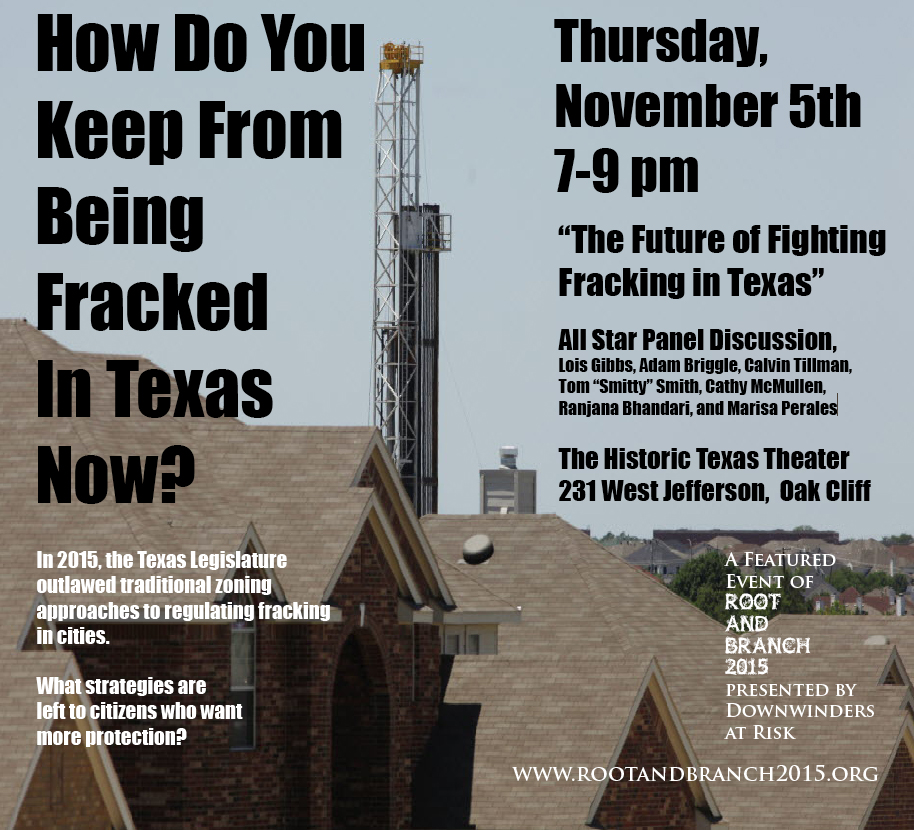 What: “The Future of Fighting Fracking in Texas”
What: “The Future of Fighting Fracking in Texas”
When: 7-9 pm Thursday, November 5th
Where: Historic Texas Theater in Oak Cliff, 231 West Jefferson
Who: Regional and Statewide Activists, Attorneys and Organizers
(Dallas)— A new alliance of groups fighting for more protective fracking regulation in Texas is using a Dallas environmental conference to host the first statewide strategy session responding to the passage of HB40 by this year’s state legislature.
Dubbing itself the “Texas Grassroots Network,” organizers include key members of local groups in Arlington, Denton, and Mansfield. Since their first meeting during the summer, they’ve also received calls from South Texas residents who live in the Eagle Ford gas and oil field. Their aim is to create something Texas has never had – a statewide coalition of grassroots groups tackling the same industry and the same problems caused by that industry setting up shop too close to people.
On the evening of Thursday, November 5th, they’re taking over Dallas’ historic Texas Theater to begin what they say will be a wide-ranging and free wheeling discussion about what the best options for those who don’t want to live side-by-side with drilling rigs in light of the legislature’s restrictions on local zoning.
“It’s time to regroup and come up new ideas and strategies about how to stop irresponsible fracking,” said Tamera Bounds, of Mansfield Gas Well Awareness. “We need to use our anger of what the legislature did to fuel new efforts and recruit new supporters. Most Texans want local control of fracking. Our job is to build a statewide movement reflecting that.”
“The Future of Fighting Fracking in Texas” is the second featured event of local clean air group’s Downwinders at Risk’s four-day floating conference, called “The Root and Branch Revue.” Other conference events include an evening of “environmental comedy” with Bar Politics, a day of workshops aimed at sharpening activist skills, and an attempt to construct “the world’s largest S.O.S” outside EPA Regional Headquarters in downtown Dallas. Lois Gibbs, of Love Canal fame, is the featured guest.
But it’s Thursday’s panel discussion and a follow-up on Saturday that could potentially have the biggest impact on the Texas environmental movement. Many opponents of urban fracking are still reeling from the state’s ban on local zoning restrictions last spring. There hasn’t yet been a coordinated or articulated response. Organizers of the Texas Theater discussion aim to fix that.
Participating will be some of the most high-profile regional fractivists, including Bounds, who’ll moderate, Adam Briggle and Cathy McMullen from Denton, Ranjana Bhandari form Arlington, and former DISH mayor Calvin Tillman. Joining them onstage on stage will be Public Citizen/Texas staffer Tom “Smitty” Smith, Austin-based environmental attorney Marisa Perales, and Lois Gibbs herself.
“HB 40 has forced us to look beyond our own city limits and find new ways to organize residents,” said Bounds. This public strategy session is one of he first steps we need to do that and regain momentum.”
DFW One of Only Ten Areas Nationwide Not Expected to Meet New Smog Standard by 2025
 There was a lot of coverage of last week's announcment of a new, more protective national smog standard by EPA. Most of it centered on the reaction by both sides that it was either not enough progress (public health advocates), or Western Civilization was about to collapse under the weight of all the controls necessary to meet the standard (National Chamber of Commerce, et al.).
There was a lot of coverage of last week's announcment of a new, more protective national smog standard by EPA. Most of it centered on the reaction by both sides that it was either not enough progress (public health advocates), or Western Civilization was about to collapse under the weight of all the controls necessary to meet the standard (National Chamber of Commerce, et al.).
But if you read deeper into the articles, many of them mentioned computer modeling EPA had already done that demonstrated, given current trends, only 14 counties, representing 10 separate areas, wouldn't be able to meet the new standard by the target year of 2025. Unfortutantely, none of those articles mentioned which 14 counties, or which 10 areas.
Now, given all that you already know about our state and regional track record for meeting clean air deadlines, your first question might be: how many of those are in Texas? We'll give you a minute or two to start a pool and pick a number….
And the answer is: Three. Brazoria and Harris Counties in the Houston "non-attainment area" for smog, and Tarrant in DFW's non-attainment area. (The ten areas are: Baltimore, Dallas-Fort Worth, Denver, Fort Collins, Houston, Louisville, Milwaukee, New Haven, New York, and Pittsburgh).
Of course, for the purposes of regional smog record-keeping, EPA doesn't separate Tarrant County numbers from Dallas County, or Denton County, or any of the other nine counties in the non-attainment area. If one monitor is out of compliance in the area, the whole region is considered in violation. So EPA is conceeding that both DFW and Houston will still continue to be in continual violation of the Clean Air Act for another decade.
This is discouraging but not surprising. The State refuses to put new-generation controls on large major polluters like the Midlothian cement plants, East Texas coal plants, and gas production facilities, while painting the rosiest scenarios with its own modeling.
But this new revelation means it's that much more important to get EPA to override the state and act now to include controls on those major polluters, while the current smog plan is in the pipeline. It may be the only chance we have in the next 5-10 years to adequately address these sources. This can only be done if the EPA decides to revoke Texas' authority to write and implement these plans – to commit to a Federal Implementation Plan of its own.
PLEASE….
1) Sign our Change.Org petition urging the EPA to reject the state's clean air plan for DFW and substitute one of its own, and
2) Send an e-mail to the Chief EPA administrator in Washington and the Regional Administrator here in Dallas saying you want them to take responsibility for a new DFW air plan.
Thanks.
EPA Lowers New Ozone Standard for Rest of the Country from 75 to 70 ppb. Texas? Not so Much.
 (Dallas)—Although they’re happy the Obama Administration is finally following its own scientists’ advice in lowering the national smog standard, local clean air activists say it won’t do North Texas residents much good as long as the state is charged with meeting it.
(Dallas)—Although they’re happy the Obama Administration is finally following its own scientists’ advice in lowering the national smog standard, local clean air activists say it won’t do North Texas residents much good as long as the state is charged with meeting it.
“When you have a state government that doesn’t believe smog is even a health problem, you’re not going to get effective enforcement of smog standards,” warned Jim Schermbeck, Director of Downwinders at Risk, the two-decade old local clean air group.
EPA officials have scheduled a Thursday afternoon briefing to announce the Agency is lowering the smog standard from the current 75 parts per billion (ppb) to 70 ppb. Although that doesn’t seem like a large change, it’s enough to prevent an additional 325,000 cases of childhood asthma and 1,440 premature deaths every year according to EPA estimates. But those numbers assume nationwide attainment of the standard. Lungs of Texas residents are routinely denied equal protection under the Clean Air Act by a state government that over 20 years has never drafted a successful smog clean-up plan for two of the most chronically-polluted metro areas in the country.
Until only a year ago, DFW was struggling just to meet the obsolete 1997 smog standard. After a mild summer in 2014, smog actually got worse this past summer, with the regional average going up. DFW officially has the worst air in the state, with a higher smog average and more monitors out of compliance. Air quality progress is stagnating. In 2010, the regional average was at 86 ppb. Today, it’s at 83.
“Texas just isn’t serious about doing what it takes to get cleaner air,” said Tamera Bounds of Mansfield Gas Well Awareness. “That’s why we need the EPA to take over the job of writing these plans so they stand a chance of actually working.”
Bounds referred to the state’s proposed clean air plan for getting to the current 75 ppb smog standard as nothing but watching a new federal gasoline mix be implemented and piggybacking its impacts. It requires no reductions from any major pollution sources. “They know it’s not going to work, and they don’t care.”
Schermbeck said Texas residents can expect more of the same when it comes to meeting a lower, more protective smog standard of 70 ppb. “If they weren’t concerned about meeting a standard of 85 or 75 in a timely way, it’s hard to imagine they’ll suddenly get religion for one at 70 ppb,” said Schermbeck, “…especially when they’re fighting it in court.”
Although EPA has final approval over any such plan, it’s usually left up to the states to draft them. Downwinders is sponsoring a campaign urging EPA to assume responsibility for writing a new clean air plan for DFW itself. Such a rebuke to a state is rare, but it’s an option under the Clean Air Act. “Breathers in North Texas who need cleaner air don’t have any confidence the state can, or even wants to do the job,” sighed Bounds. “Our only hope is EPA.”

